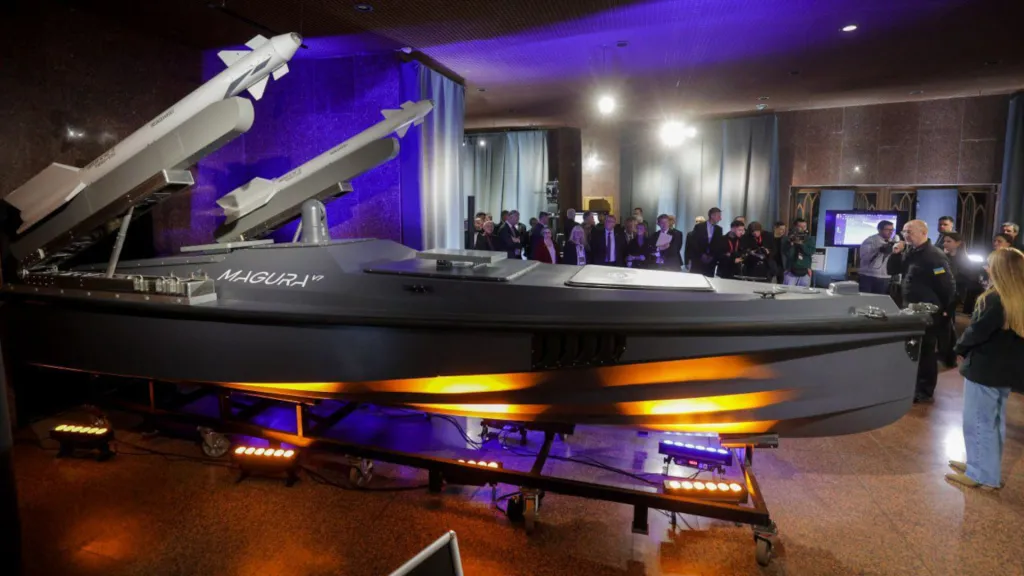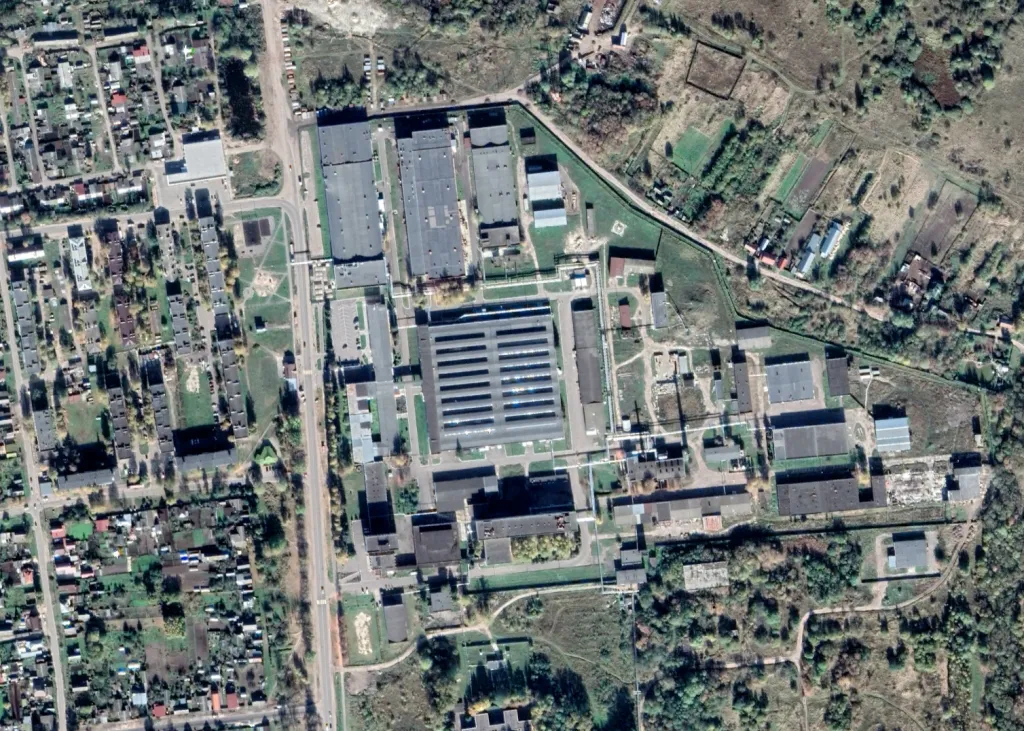New ‘Bulged’ Neptune Cruise Missile Variant Emerges In Ukraine
Ukraine has unveiled a new version of its Neptune cruise missile, which appears to have added fuel tank ‘bulges’ for increased range. The missile looks to be distinct from the extended-range Long Neptune derivative, imagery of which first emerged earlier this year. Originally designed as an anti-ship weapon, the Neptune family has now become a key means for Ukraine to launch strikes at targets on land inside Russian territory.
Denys Shmyhal, Ukraine’s defense minister, shared a picture of the new Neptune variant, seen at the top of this story, on social media today in relation to a recent visit by Lithuanian Prime Minister Inga Ruginiene and other Western dignitaries. Other domestically developed weapon systems that Ukrainian authorities have showcased before, including the Peklo ‘missile drone’ and a Magura-7 uncrewed surface vessel (USV) armed with R-73 anti-air missiles, were also put on display for the delegation.

The baseline Neptune, also designated the R-360, is primarily an anti-ship weapon, but has a basic secondary land attack capability. It is itself derived from the Soviet-era Kh-35, variants of which remain in service in Russia and elsewhere globally. Current production Neptunes can be readily distinguished from Kh-35s by the shape of their main fins, which have a distinctive stepped or ‘cranked’ sweep to them. The missile, which is powered by a small turbofan jet engine, has a stated maximum range of 190 miles (300 kilometers), according to the developer, the Luch Design Bureau.


Since 2023, Ukraine has also been employing a land-attack optimized version, which reportedly has a guidance package that combines a GPS-assisted inertial navigation system (INS) and an imaging infrared sensor in place of the original active radar seeker. A Ukrainian defense official previously told TWZ that this variant has a range of at least 225 miles (360 kilometers). There is also the Long Neptune, which we will come back to later on.
The new Neptune variant shown to Prime Minister Ruginiene and the other Western officials has two prominent bulges on either side of the forward body immediately in front of the main fins. Though their purpose is currently unknown, additional fuel tanks are the likely explanation. Adding more fuel would be a relatively straightforward way to extend the missile’s reach without dramatically changing its design. It could also help maintain the weapon’s existing range following the addition of a heavier payload, such as a new warhead, although this is less likely based on what we know about the Neptune design. It is possible that fuel was added here to makeup for a larger warhead, but again, this is the less likely of the two options.

It’s possible the fairings could contain something else, but nothing logical comes to mind. Based on what is known of the Kh-35’s internal layout, this portion of the Neptune’s body should otherwise house elements of its navigation system and avionics. The missile’s warhead should be directly in front of that section, with the main seeker then in the nose.
As noted, the missile does not appear to be the Long Neptune derivative, also known as the RK-360L, which has a reported maximum range of 621 miles (1,000 kilometers). Ukrainian authorities released an image of that missile in August, which shows that it is externally very distinct from earlier Neptunes, as well as the new variant that has now been revealed. The Long Neptune is longer overall and has a wider main body, with the tail and nose sections having tapered profiles as a result. The main fins are also bigger and have a straight sweep.

Extending the reach of the baseline Neptune would offer a new tier of capability between the original missile and the RK-360L, allowing for the latter to be reserved for strikes that make use of their full range. An extended-range variant of the R-360 might also be cheaper and/or easier to produce than the Long Neptunes, or even something that could be created by converting existing missiles.
It’s also worth noting here that increasing the reach of the baseline Neptune could be relevant to expanding Ukraine’s ability to target Russian ships at sea, as well as strikes on land targets.
Existing versions of Neptune have also proven to be especially key weapons in Ukraine’s arsenal for conducting strikes on targets inside Russia. Ukraine’s Navy claims to have successfully struck more than 50 Russian targets with Neptune-series cruise missiles in the past year, according to an interview with the service’s spokesperson, Dmytro Pletenchuk, which Ukrainian newspaper Dzerkalo Tyzhnia published just today.
The expanding Neptune family also reflects a broader push by Ukrainian authorities to step up domestic arms production. Ukraine’s President Volodymyr Zelenskyy has said the goal is for 50 percent of all munitions being used on the front lines to be manufactured within the country by the end of the year. Foreign partnerships are part of the plan to achieve this, according to Zelenskyy. It is possible that the ongoing development of the Neptune family, as well as the production of those missiles, may already be benefiting from collaboration with allies and partners.
When it comes to stand-off strike capabilities capable of hitting targets deeper inside Russia, Ukraine’s current arsenal includes air-launched Storm Shadow and SCALP-EG cruise missiles provided by the United Kingdom and France, respectively, as well as ground-based Army Tactical Missile System (ATACMS) short-range ballistic missiles from the United States.
In addition, Ukrainian forces have access to an extensive array of domestically-produced long-range kamikaze drones, as well as munitions that blur the line between those weapons and traditional cruise missiles, like the aforementioned Peklo. The country unveiled a new ground-launched cruise missile, called Flamingo, which reportedly has a range of 1,864 miles (3,000 kilometers) and a warhead weighing 2,535 pounds (1,150 kilograms), in August, as well. Ukraine also has an active domestic ballistic missile program, but how close it is to delivering a useful operational capability is unclear.
Earlier this year, the U.S. government also approved the delivery to Ukraine of thousands of new and relatively low-cost standoff missiles developed under the Extended Range Attack Munitions (ERAM) program. There is now talk that Ukraine could receive additional long-range strike munitions from its American partners, possibly including Tomahawk cruise missiles. Tomahawks would give Ukraine a new means to hold any target within roughly 1,000 miles of its borders at risk.
“I’ve sort of made a decision, pretty much,” U.S. President Donald Trump said yesterday in response to a direct question about Tomahawks for Ukraine. “I think I want to find out what they’re doing with them. Where are they sending them, I guess. I’d have to ask that question.”
In a post on Facebook yesterday, Yegor Chernev, a member of Ukraine’s parliament from Zelenskyy’s Servant of the People party and deputy chairman of the country’s parliamentary committee on national security, raised significant questions about any future Tomahawk deliveries. He specifically called out how long it might take for the missiles to actually be delivered and restrictions American authorities might impose on their employment.
Trump had also said yesterday that he was “not looking to see an escalation” in the ongoing conflict in Ukraine. The President has previously pushed back on the possibility of sending long-range missiles to Ukraine over concerns about escalation. Former President Joe Biden and other members of his administration also regularly highlighted the potential for escalation as a key factor in discussions about expanding the scale and scope of aid to Ukraine, especially in terms of weapons capable of striking Russia.
Trump’s comments do follow a major change in the U.S. government’s stance regarding Ukraine, as well as Russia, in recent weeks. Earlier in the year, the Trump administration’s relationship with Ukraine had dramatically cooled, and the flow of American aid to Ukrainian forces was notably disrupted. Washington had moved to engage more with Russia, which led to a summit between Trump and Russian President Vladimir Putin in Alaska in August. Since then, however, the U.S. President has been increasingly outspoken in his frustration with his counterpart in Russia, especially over the lack of progress on a deal to end the war in Ukraine.
In the meantime, further iterating on the Neptune design continues to offer Ukraine a valuable way to expand its long-range strike capabilities and capacity domestically.
Contact the author: [email protected]




